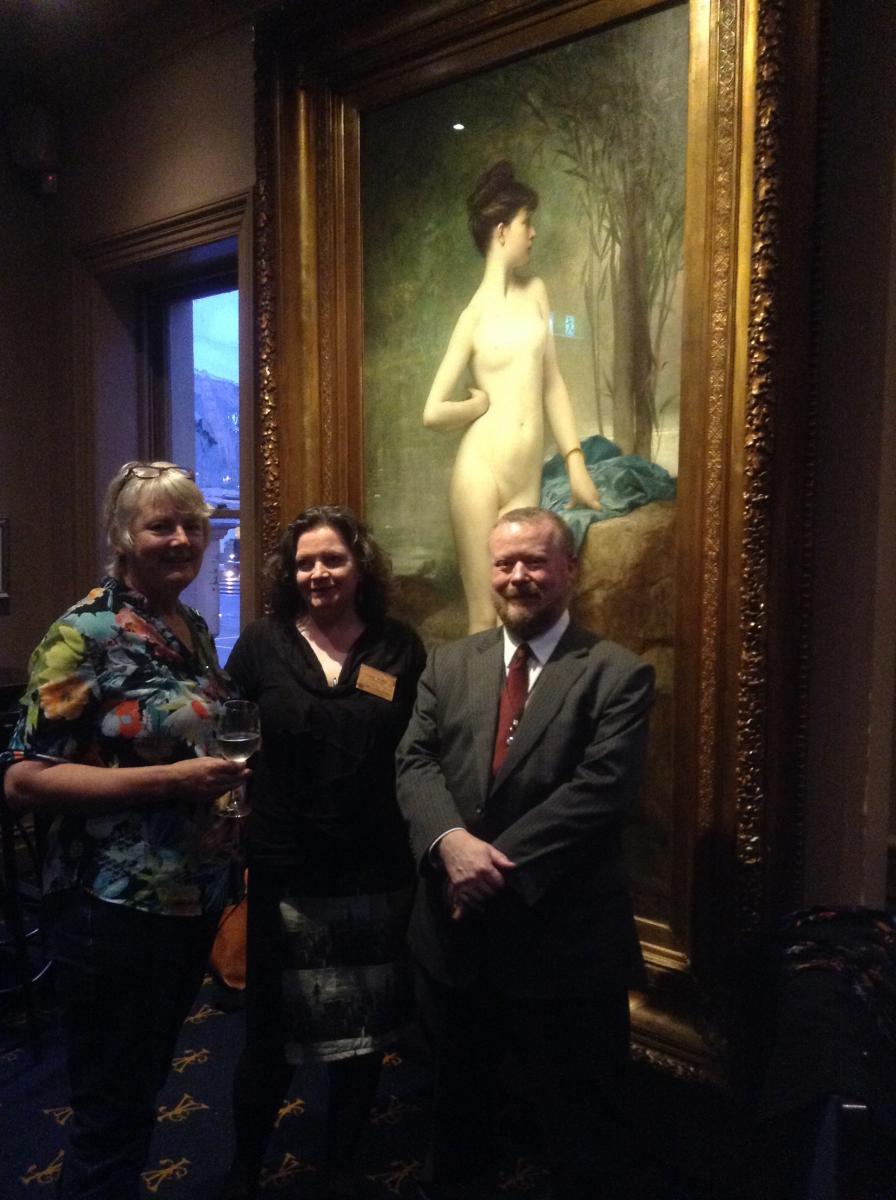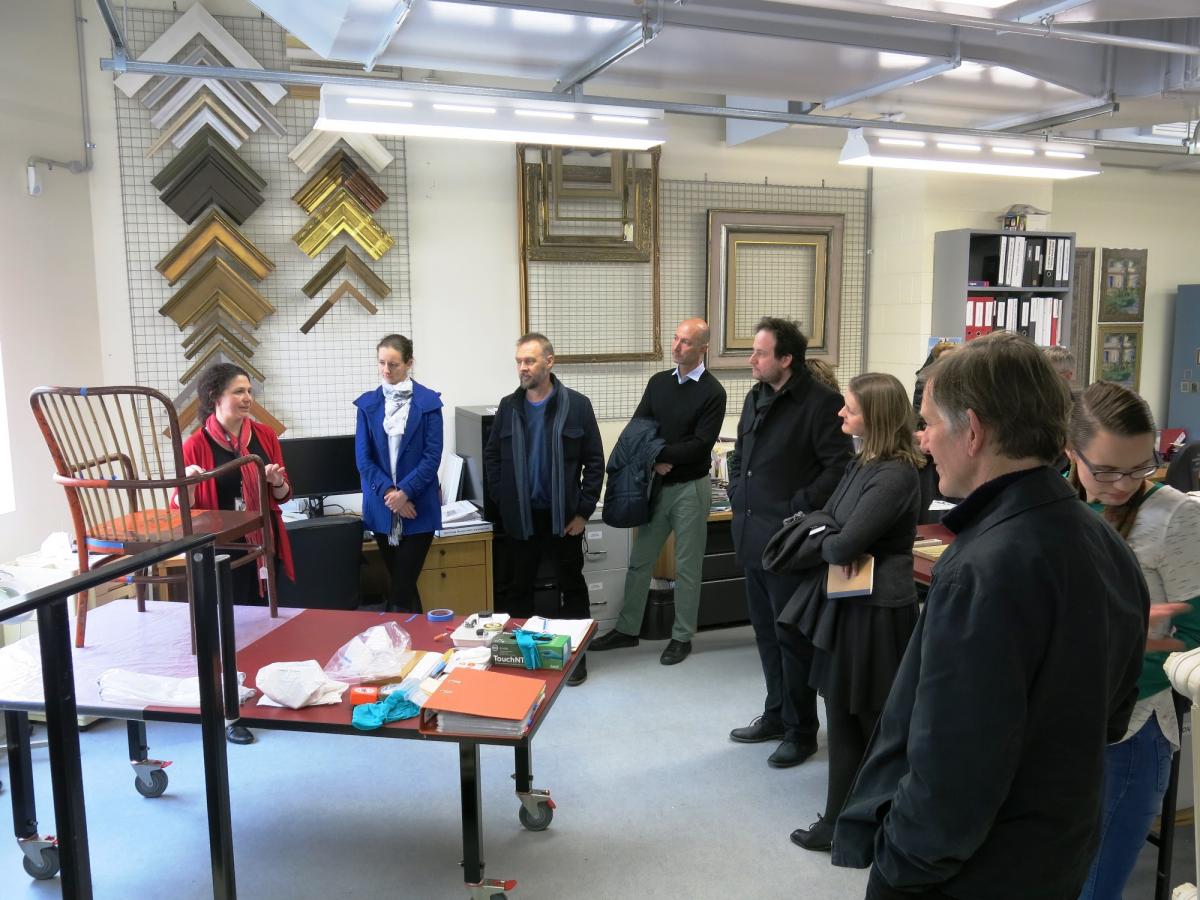AICCM FRAME: Concept, History and Conservation
National Gallery of Victoria, Melbourne
In August we held our first international frame symposium, generously hosted by the National Gallery of Victoria. The symposium was a joint meeting of the Conservation Framers and the Gilded Objects Conservation special interest groups so we attracted a good mix of delegates including conservators, curators and framers. Twenty speakers presented twenty-two papers and lighting talks covering many themes including the philosophy and theory of the frame to the history and conservation of frames.
We were very pleased to have two world experts on frames as keynote speakers, Dr Eva Mendgen, and Lynn Roberts. Lynn also presented the public lecture How Pre-Raphaelite Frames influenced Degas & the Impressionists, which was well received by a very large audience.Australian frame experts Holly McGowan-Jackson, John Payne and Dr Malgorzata Sawicki shared their extensive knowledge inkeynote talks.

The symposium concluded with site visits to the conservation labs of the National Gallery of Victoria, the Grimwade Centre for Cultural Materials Conservation and Museum Victoria. Jane Hinwood, conservator, and Madeleine Say, Pictures Librarian, welcomed attendees to the State Library of Victoria for a tour and a floor talk of the William Strutt exhibition, Heroes and Villains: Strutt’s Australia.
The members of the organising committee are very grateful to everyone who helped to make the symposium so successful. Special thanks go to AICCM National Council, especially Michelle Berry, Helen Privett, and Hilary Milsome for their organisational support. We would like to thank the National Gallery of Victoria for hosting the symposium and providing the fine multimedia technical support. Holly McGowan-Jackson, Suzi Shaw and John Payne did an enormous amount of work behind the scenes on the program and many other important details. We are grateful for sponsorship support from trade exhibitors Antons & Bellini Fine Moulding and Giusto Manetti Battiloro, represented by Carolina Izzo, The Gold Leaf Shop, Archival Survival for symposium bag sponsorship and WERNER MURRER RAHMEN, for supporting the travel of curator Marei Döhring. We acknowledge too the Art Gallery of New South Wales for supporting the attendance of Barbara Dabrowa and Dr Malgorzata Sawicki.
For more detail about the symposium please read the reviews below by curator Louise Box, and conservator Robert Zilli. And finally thanks to organising committee members Barbara Dabrowa and Holly McGowan-Jackson for their hard work.
With the feedback from this symposium we have begun planning the next AICCM – FRAME symposium to be held in Sydney in October 2019. We welcome any suggestions for speakers or a theme.

Review by Robert Zilli
Conservation Framer, Queensland Art Gallery | Gallery Of Modern Art
2016 was witness to something extraordinary, two international picture frame conferences taking place only months apart, however due to my geographic location, I was only able to attend one of these events. FRAME: Concept, History and Conservation, was presented by AICCM Conservation Framing and Gilded Objects Special Interest Groups and hosted by The National Gallery of Victoria in Melbourne from the 24th to 26th of August.
This symposium was the culmination of meticulous planning undertaken by convenors Louise Bradley, Barbara Dabrowa and Holly McGowan-Jackson. Coinciding with the NGV exhibition ‘Degas: A New Vision’ the timing of the symposium could not have been more appropriate considering the importance Degas bestowed on the picture frames he designed for his paintings. Although only a handful of original Degas frames were included in the exhibition, there were also some fine examples of replica Degas frames on display.
The conference drew a diverse array of individuals from various disciplines such as conservators, historians, frame makers, commercial picture framers, artists and academics. Although an international symposium the predominant cohort was from Australia, however representation from abroad was of a very high calibre attracting frame scholars and experts from New Zealand, Germany and England. The papers presented over the three days varied from the customary topics such as frame history and research, and conservation treatments, through to papers considering the future of frames conservation, ethical use of period frames and the philosophical nature of the role of the frame in 21st century art.
The format for the first two days of the symposium consisted of six to seven presenters plus two Keynote speakers, who were allotted half an hour to present their papers; the mid afternoon sessions comprised of 10 minute lightning talks.
The very well attended public lecture presented by Lynn Roberts—‘How Pre Raphaelite frames influenced Degas & the Impressionists’—concluded proceedings on the first day. Post-symposium evening social events were very well organised and attended, with drinks and canapés in Chloe’s bar at Young and Jackson’s on the first night and dinner at the restaurant Charcoal Lane in Fitzroy. The third day saw the final papers presented in the morning session followed by a closing forum discussing the merits of developing a compendium of frame nomenclature. The symposium concluded with final announcements and a discussion on the next frame symposium, which provided stimulating debate amongst those in attendance. Site visits to various conservation labs in Melbourne occupied the afternoon, which provided a behind the scenes insight to the workings of these departments.
As mentioned the discussion regarding the next frame symposium generated and raised some very compelling issues. Therefore to maintain the relevance of symposiums such as FRAME: Concept, History and Conservation, the way in which such events are presented needs to be revised, and new audiences engaged by embracing and including experts from other vocational, professional and academic fields. If not there is the prospect of reiteration and inaccessibility. Engaging a wider audience will provide such events with a broader perspective and potential innovation.
Review by Louise Box
PhD Student (Art History), University of Melbourne
As a scholar of art history and curatorship, attending the FRAME: Concept, History and Conservation Symposium was a revelation. As I described to other delegates, ‘degrees in art history, arts management and art curatorship at three universities in two countries over 30 years’, seemed to have barely scratched the surface of the complexity, context or the materiality of the frame and its impact on the interpretation of artwork. As a newcomer to both AICCM and the world of frames, the symposium was a thought-provoking introduction that has changed the way I consider frames in my own scholarly practice.
The three-day conference, ably and generously hosted by the NGV, combined a balanced selection of local and international speakers, panellists and visits. As neither a frame specialist nor a conservator, I was impressed with the variety and depth of information that was presented in an accessible, engaging and nuanced way. Topics ranged from practical insights into recent conservation projects; theoretical contexts; reflections on ethics and institutional decision making; and wider observations on the current and future state of the profession. Also fascinating from an art historical perspective, was the scope of framing styles and eras addressed, including the ‘extended’ frame in contemporary art, Degas’ frames, conservation challenges in the Philippines, German Expressionist frames and the rediscovery of frames originally used by Tom Roberts, to name but a selection.
Keynote speaker Lynn Roberts’ sleuthing of frame-makers’ labels across the Atlantic was a fascinating insight into provenance and the value of memory and a considered eye. With Reuben Rich we peeped into the eclectic workshops of Italian and Turkish artisans. Holly McGowan-Jackson, John Payne, Emma Rouse, Barbara Dabrowa, Robert Zilli, MaryJo Lelyveld and Suzanna Shaw provided richly illustrated explorations into frames and projects in institutional settings, and Dr Eva Mendgen, Dr Anthony Springford, Toby Miller, and Dr Ian Geraghty’s presentations positioned theory and practice. The future of frame conservation education was considered by Dr Margaret Sawicki. Matthew O’Reilly, Mark Searle and Anna Maria Luisa Garcia (presented by Louise Bradley), Helen Gramotnev and Marei Dohring shared case studies and specific projects.

John Payne, Senior Conservator at the NGV, generously prepared a printed guide to significant frames at NGV Australia and NGV International, some of which were exhibited specifically for this conference. This guide, combined with site visits to the Conservation Departments of the NGV, the Grimwade Centre for Cultural Materials Conservation (University of Melbourne), the State Library of Victoria, and Museum Victoria ensured delegates could fully engage with practical examples and discuss working methods and approaches with colleagues.
I will highly recommend future conferences to art historians, curators and art educators, and would encourage conference organisers to consider low-cost registration to maximise the attendance of emerging scholars in these disciplines. Many thanks to the hosts and organisers, particularly Louise Bradley (Louise Bradley Framing and AICCM Conservation Framers SIG Convenor) and Holly McGowan-Jackson, Senior Conservator of Frames and Furniture, NGV, for their warm welcome and for providing a stimulating cross-disciplinary platform for discussion and collaboration.